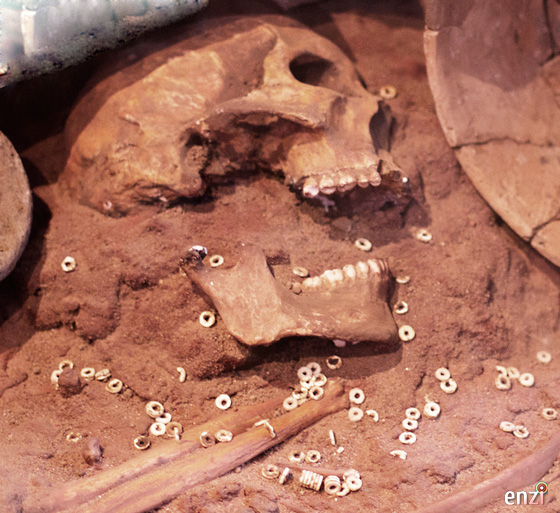Enkapune Ya Muto
45,000 – 12,000 years ago
Enkapune Ya Muto can be translated to mean ‘Twilight Cave.’ The discoveries at this cave in Kenya’s Rift Valley are a watershed moment for the story of our ancestors and the development of culture leading to the present day.
 A handful of beads dated to about 45,000 – 40,000 years ago were dug up by archaeologists are interpreted as evidence of the earliest known jewellery. The beads may have also been used as gift tokens, making them the earliest known form of symbolism.
A handful of beads dated to about 45,000 – 40,000 years ago were dug up by archaeologists are interpreted as evidence of the earliest known jewellery. The beads may have also been used as gift tokens, making them the earliest known form of symbolism.
The use of symbols marks the flowering of imagination and advanced congnitive skills. From this point, our self-aware ancestors would lay the goundwork and herald the development of even more advanced tools and weapons, complex social networks for mutual security, agriculture and civilisation.
Some scientists speculate that around this time marks humanity’s big bang moment, sparked by a sudden increase in brain quality.
“ In each great region of the world the living mammals are closely related to the extinct species of the same region. It is, therefore, probable that Africa was formerly inhabited by extinct apes closely allied to the gorilla and chimpanzee; and as these two species are now man’s nearest allies, it is somewhat more probable that our early progenitors lived on the African continent than elsewhere. But it is useless to speculate on this subject, for an ape nearly as large as a man, namely the Dryopithecus of Lartet, which was closely allied to the anthropomorphous Hylobates, existed in Europe during the Upper Miocene period; and since so remote a period the earth has certainly undergone many great revolutions, and there has been ample time for migration on the largest scale.”
Charles Darwin, Descent of Man, 1871
Between this time and 12,000 years ago, hunter gatherer groups continued their way of life, in all directions across the continent and beyond. Stone tools continued to be refined (using material such as chert and obsidian) and there is evidence from sites the like Lukenya Hills which have yielded lots of clues of life in the Late Stone Age.
Lake and river levels rose and fell, rivers changed courses and climate change caused changes in vegetation and the migration patterns of animals. Our foragers ancestors adapted to various changing environments combining a diet of meat collected from tactical (planned) killings of migratory animals (Zebra, Eland, even Giraffe) with plants and in some cases diversified with snails and fish. Fishing would have been done with lines, nets and harpoons.
There is even evidence of long distance “trade” or exchange in goods such as ochre and obsidian (used for stone tool manufacture). Individuals would have adorned themselves with jewellery in the form of beads made from materials like ostrich shell and decorated themselves with ochre.
